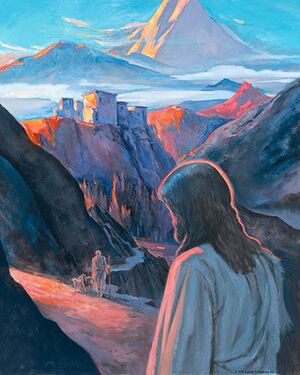Issa/es: Difference between revisions
(Created page with "El joven Jesús llegando a Ladakh, India.") |
(Updating to match new version of source page) |
||
| (14 intermediate revisions by 2 users not shown) | |||
| Line 1: | Line 1: | ||
<languages /> | <languages /> | ||
[[File:0001166 jesus-approaching-ladakh-900-G 600.jpeg|thumb | [[File:0001166 jesus-approaching-ladakh-900-G 600.jpeg|thumb|alt=caption|El joven Jesús llegando a Ladakh. J. Michael Spooner.]] | ||
[[File:Issa-pond-le.jpg|thumb|upright|<span lang="en" dir="ltr" class="mw-content-ltr">''Issa Pond'', Nicholas Roerich (c. 1926)</span>]] | |||
En 1887, el médico ruso Nicolas Notovitch viajó a la ciudad tibetana de Himis, en lo alto de la cordillera del Himalaya, en busca de escritos antiguos sobre la vida de un hombre al que los budistas llamaban “Santo Isa”. En el monasterio de Himis, el lama principal le leyó manuscritos antiguos; entonces Notovitch escribió la historia de Isa, un israelita que viajó al Oriente para estudiar las sagradas escrituras y luego regresó para enseñarlas a su pueblo, en Palestina, y ahí fue crucificado. | |||
Las similitudes entre el Santo Isa y [[Special:MyLanguage/Jesus|Jesús]] fueron notables, esto llevó a Notovitch a concluir que los manuscritos proporcionaban el relato (ausente en la Biblia) de la vida de Jesús entre los 13 y los 30 años. Publicó la historia de su descubrimiento en 1890 en ''Life of Saint Issa'' (traducción al inglés ''The Unknown Life of Christ'', 1895). Según Notovitch, los manuscritos originales Pali de la vida del Santo Isa estaban en la biblioteca de Lhasa, en [[Special:MyLanguage/Tibet|Tibet]], donde residía el Dalai Lama. | |||
Los críticos afirmaron que el relato de Notovich sobre los manuscritos era falso. Sin embargo, en 1922, Swami Abhedananda, un erudito y discípulo del santo hindú [[Special:MyLanguage/Ramakrishna|Ramakrishna]], vio los mismos documentos en Himis. El arqueólogo, autor, artista y filósofo ruso [[Special:MyLanguage/Nicholas Roerich|Nicholas Roerich]] también observó los mismos documentos, o similares, en 1925. Roerich también descubrió que el viaje de Jesús al Oriente formaba parte de la historia oral de la región. Dijo: "¿De qué manera podría una falsificación reciente penetrar en la conciencia de todo Oriente?". | |||
== | <span id="See_also"></span> | ||
== Véase también == | |||
[[Lost years of Jesus]] | [[Special:MyLanguage/Lost years of Jesus|Años perdidos de Jesús]] | ||
== | <span id="For_more_information"></span> | ||
== Para más información == | |||
{{LYJ}} | {{LYJ-es}} | ||
== | <span id="Sources"></span> | ||
== Notas == | |||
{{POWref|25|58}} | {{POWref-es|25|58}} | ||
Elizabeth Clare Prophet, | Elizabeth Clare Prophet, 6 de octubre de 1987. | ||
Latest revision as of 21:55, 19 May 2024


En 1887, el médico ruso Nicolas Notovitch viajó a la ciudad tibetana de Himis, en lo alto de la cordillera del Himalaya, en busca de escritos antiguos sobre la vida de un hombre al que los budistas llamaban “Santo Isa”. En el monasterio de Himis, el lama principal le leyó manuscritos antiguos; entonces Notovitch escribió la historia de Isa, un israelita que viajó al Oriente para estudiar las sagradas escrituras y luego regresó para enseñarlas a su pueblo, en Palestina, y ahí fue crucificado.
Las similitudes entre el Santo Isa y Jesús fueron notables, esto llevó a Notovitch a concluir que los manuscritos proporcionaban el relato (ausente en la Biblia) de la vida de Jesús entre los 13 y los 30 años. Publicó la historia de su descubrimiento en 1890 en Life of Saint Issa (traducción al inglés The Unknown Life of Christ, 1895). Según Notovitch, los manuscritos originales Pali de la vida del Santo Isa estaban en la biblioteca de Lhasa, en Tibet, donde residía el Dalai Lama.
Los críticos afirmaron que el relato de Notovich sobre los manuscritos era falso. Sin embargo, en 1922, Swami Abhedananda, un erudito y discípulo del santo hindú Ramakrishna, vio los mismos documentos en Himis. El arqueólogo, autor, artista y filósofo ruso Nicholas Roerich también observó los mismos documentos, o similares, en 1925. Roerich también descubrió que el viaje de Jesús al Oriente formaba parte de la historia oral de la región. Dijo: "¿De qué manera podría una falsificación reciente penetrar en la conciencia de todo Oriente?".
Véase también
Para más información
Elizabeth Clare Prophet, Los Años Perdidos de Jesús: Pruebas documentales do los diecisiete años en que Jesús viajó a Oriente
Notas
Perlas de Sabiduría, vol. 25, núm. 58.
Elizabeth Clare Prophet, 6 de octubre de 1987.
